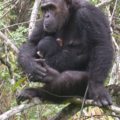
Some regions of the human genome have been hotspots for acquiring duplicated DNA sequences, but only at specific time-points during evolution. Researchers say that long periods of genomic stasis, in regard to the accretion of duplicated DNA fragments, are “punctuated” by relatively brief episodes of duplicative activity. The study, appearing in Genome Research, is the first where such temporal bias has been documented for DNA duplications, and it challenges the evolutionary paradigm of continuous alterations.
“Primate genomic sequence comparisons are becoming useful for elucidating the evolutionary history and organization of our own genome. Such studies are particularly informative within human pericentromeric regions – areas of rapid change in genomic structure,” said study leader Evan E. Eichler, from the University of Washington. Pericentromeric regions are sequences of DNA that lie in close proximity to the centromere, which plays a critical role in chromosomal separation during cell division. Pericentromeric regions contain an abundance of segmental duplications, which are large DNA sequences that exhibit strong similarity to the euchromatic ancestral loci from which they were copied. According to Eichler, the limited number of comparisons of pericentromeric regions among closely related primates suggests extraordinary dynamism, where duplication, deletion, and rearrangement of large segments of DNA occur on a huge scale.
“It is unclear why pericentromeric seeding events have occurred so frequently during this period of human/great-ape evolutionary history. It is also unclear as to why they suddenly cease, at least in the case of this pericentromeric region of chromosome 2,” said Eichler. “Other regions may show different temporal biases. The important implication here is that episodic bursts of activity challenge the concept of gradual clock-like changes during the course of genome evolution. Since duplications are important in the birth of new genes and large-scale chromosomal rearrangements, it may follow that these processes may have gone through similar episodes of activity followed by quiescence.”


















Comments are closed.